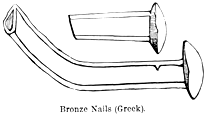Clavus
(
ἦλος, γόμφος). A nail. In the subterranean chamber at
Mycenae (q.v.), supposed to be the treasury of
Atreus, a view of which is given in Sir W. Gell's
Itinerary of Greece (plate
vi.), the stones of which the cylindrical dome is constructed are perforated by regular series
of bronze nails, running in perpendicular rows, and at equal distances, from the top to the
bottom of the vault. It is supposed that they served to attach thin plates of the same metal
to the masonry, as a coating for the interior of the chamber; and hence it is that these
subterranean works, which served for prisons as well as treasuries, like the one in which
Danaé is said to have been confined, were called by the poets “brazen
chambers.” Two of these nails are represented in the annexed illustration, of two
thirds the real size; they consist of 88 parts of copper to 12 of tin.
 |
|
Bronze Nails (Greek).
|
Nails of this description were termed
trabales and
tabulares by the Romans, because they were used, in building, to join the larger beams
(
trabes) together. Hence Horace arms Necessitas with a nail of the same
kind, or of adamant, wherewith to rivet, as it were, irrevocably the decrees of Fortune. Thus,
too, Atropos is represented in the following illustration, taken from a cup found at
 |
|
Atropos driving a Nail.
|
Perugia, upon which the story of Meleager and Atalanta is embodied, with a hammer in
her right hand, driving a nail which she holds against the wall with her left.
The next cut represents a nail of Roman workmanship, which is highly ornamented and very
curious. Two of its faces are given, but the pattern varies on each of the four.
 |
|
Ornamental Nails. (Roman.)
|
It is difficult to say to what use this nail was applied. The ornamented head shows that it
was never intended to be driven by the hammer; nor would any part but the mere point, which
alone is plain and round, have been inserted into any extraneous material. It might possibly
have been used for the hair, in the manner represented in the illustration under
Acus.
Bronze nails were used in ship-building, and to ornament doors, as exhibited in those of the
Pantheon at Rome; in which case the head of the nail was called
bulla,
and richly ornamented. See
Bulla.
The soles of the shoes worn by the Roman soldier were also studded with nails, thence called
clavi caligarii. (See
Caliga.)
These do not appear to have been hobnails for the purpose of making the sole durable, but
sharp-pointed ones, in order to give the wearer a firmer footing on the ground. The men
received a donative for the purpose of providing themselves with these necessaries, which was
thence called
claviarum.







